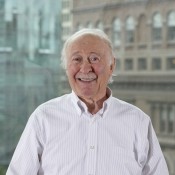Math in Art
This course is designed for Art and Architecture students. It has also been well attended by Engineering students as its point of view is complementary to the application oriented mathematics courses that comprise the mathematics component of the engineering curriculum. The same version of the course has never been given twice. It was first taught in 1968 and has been taught at least once per year since. There is one three hour session per week, currently meeting Wednesdays 6:00 to 9:00pm. The instructor is Prof. Bailyn.
The course primarily consists of a menu of topics (growing over the years) from which choices are made by the students and the instructor. The basic purpose of the course is to give the students a sense of what mathematics is about and how it informs and is nurtured by other disciplines. The following is a sampling:
1- History. As a “backbone” for the course a historical viewpoint is always presented starting with ancient Greece. A half dozen theorems are presented with rigorous proofs (one per week) showing how modern and sophisticated mathematics was in Greece from about 500 BC (Pythagoras) to about 50 BC (Euclid.) There is then a jump to the mid 19th century when Euclid’s “parallel statement” issue was resolved and what can be called “contemporary” mathematics was born (e.g., non-Euclidean geometries and topology.)
2- Infinity. How do we deal with infinity in mathematics? Potential vs actual infinity. Different levels of infinity. George Cantor. How to count 572 sheep when you can’t count beyond 3.
3- Paradoxes- There are 3 kinds. Examples of each. Bertrand Russell.
4- Geometry of curves- What is curvature? Special curves such as conic sections, cycloids, spirals.
5- Geometry of surfaces- What is curvature of surfaces? Moebius strips. Ruled surfaces. Types of points on surfaces. What result did Gauss call his most amazing theorem?
6- Topology (Rubber Sheet Geometry)- Why topologists can’t tell the difference between a coffee cup and a donut. What turns Topology into Geometry?
7- Numbers- Imaginary, Real, Irrational, Transcendental, Indescribable.
8- Higher Dimensions. Why stick to only 3 or 4?
9- Kurt Goedel. The incompleteness theorem. Undecideable propositions. Implications for AI and consciousness. Is there a limit as to what is knowable?
10- The Poincare Conjecture. What is it? What does it imply about the universe we live in?
11- Soap Film Demonstrations. The blind leading the sighted. Surfaces of mean curvature zero illustrating so much.
12,13,14,… Discussions of Special and General Relativity , Quantum Physics (Einstein thought it was nonsense but it got him his Nobel- the Photoelectric Effect, the EPR Paradox, Entanglement.), Astronomy (motivated much mathematics), Cosmology (were the ancient Greeks right that the universe is made of 5 substances?, What lies beyond the Cosmic Horizon?, Hubbles Law),Entropy (Stephen Hawking, Big Bang vs Black Holes), Fractals and Constructals- Chaos, …
For homework the students are presented each week with at least 2 puzzles and/or paradoxes to solve/resolve which are then discussed at the start of the following week’s session. These brain teasers illustrate principles that are developed in the course. There is also a standing assignment to peruse the Science section of the Tuesday New York Times. Any relevant items of interest are discussed in class. This is done to keep the course “current.” Sometimes there aren’t any items of interest but often something is found to work with and occasionally we find something of great interest (e.g., the Poincare Conjecture and Fermat’s Last Theorem.)
From time to time there are guest speakers. If there is something relevant at the Rose Space Center or the MOMA or some other venue the class will take a field trip. Sometimes videos are shown related to the course work.
There is no single text that is used but a list of fascinating books that have enriched the course is presented (with authors such as Stephen Hawking, Brian Green, Douglas Hofstadter, Roger Penrose, Richard Courant, James Newman, David Hilbert, Darcy Thompson, Rebecca Goldberg and Donal O’Shea.)
The course is project based. The last several weeks are devoted to the student presentation of projects. These projects are determined through one-on-one discussion with the instructor.
A sampling of projects presented by students in recent years is as follows: Polyhedra, Neural Prosthetics, Paradoxes, Fibonacci Sequences, Press Board Sculpture, The Number e, Flexagon Templates, Chisenbop, Math of Juggling, Alphabet Design, Computer Simulation of Four Flies Problem, Escher Patterns, EKG Math, AI Game Tree for Othello, Constructals in the City, Egyptian Pyramids, Buckminster Fuller, Fractals, Golden Ratio, Modern Inventions on Perspective Drawing, Flatland, Soap Film Demonstrations, Pascal’s Triangle, Shapes of Constant Width, Hyperboloid Structures, Prime Numbers, The number zero, The Rhombic Dodecahedron, Math Perspective in Photography, Pi in the Bible, The Mayan Calendar, The Twin Paradox, Goedel’s Incompleteness Theorem, Goedel Numbering, Holograms, Black Holes, Polyhedra in Nature, Entropy and Art, Sudoku and other Puzzles, Number/Color Relations, Card Counting, Tesselations, Islamic Patterns, The Zodiac, Math and Crime, Tangrams, Knot Theory, Linear Programming, Math in Origami.
In the instructor’s opinion these presentations by the students comprise the best part of the course.

